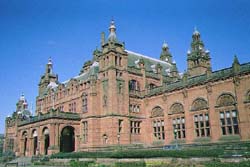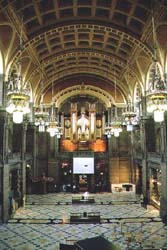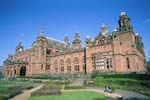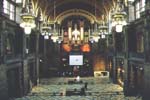
|
It was then decided that a larger building should be built at Kelvingrove to bring the city's art and museum collections together. Until then the city's art collection was housed at the McLellan Galleries. To raise money for the project, an International Exhibition was held in Kelvingrove Park in 1888. |
|
In 1891 the Association for the Promotion of Art and Music launched a competition for the design of the new building. The ambitious original specification included a School of Art and a Concert Hall, but these were later dropped. The winning design was submitted by John W. Simpson and E.J. Milner Allen. However, the Association ran out of money in 1896, placing the completion of the project in jeopardy. Glasgow Corporation then took over the project, and the marble foundation stone was laid in 1897 by the Duke of York. |
 |
 |
The new building was officially opened in 1901 by Princess Louise, Duchess of Fife. To celebrate the opening, another International Exhibition was held in Kelvingrove Park. This exhibition involved the construction of huge temporary buildings. An ornate Industrial Hall and Concert Hall were built in Kelvingrove Park, and an equally splendid Machinery Hall was built on the site of what is now the Kelvin Hall. The 1901 Exhibition was a great success, and when it closed many of its exhibits were transferred to the new Art Gallery and Museum, along with the art collection from the McLellan Galleries and the scientific collection from Kelvingrove House. This combined collection was now the city's largest. The new Art Gallery and Museum was finally opened to the public in 1902.
|

